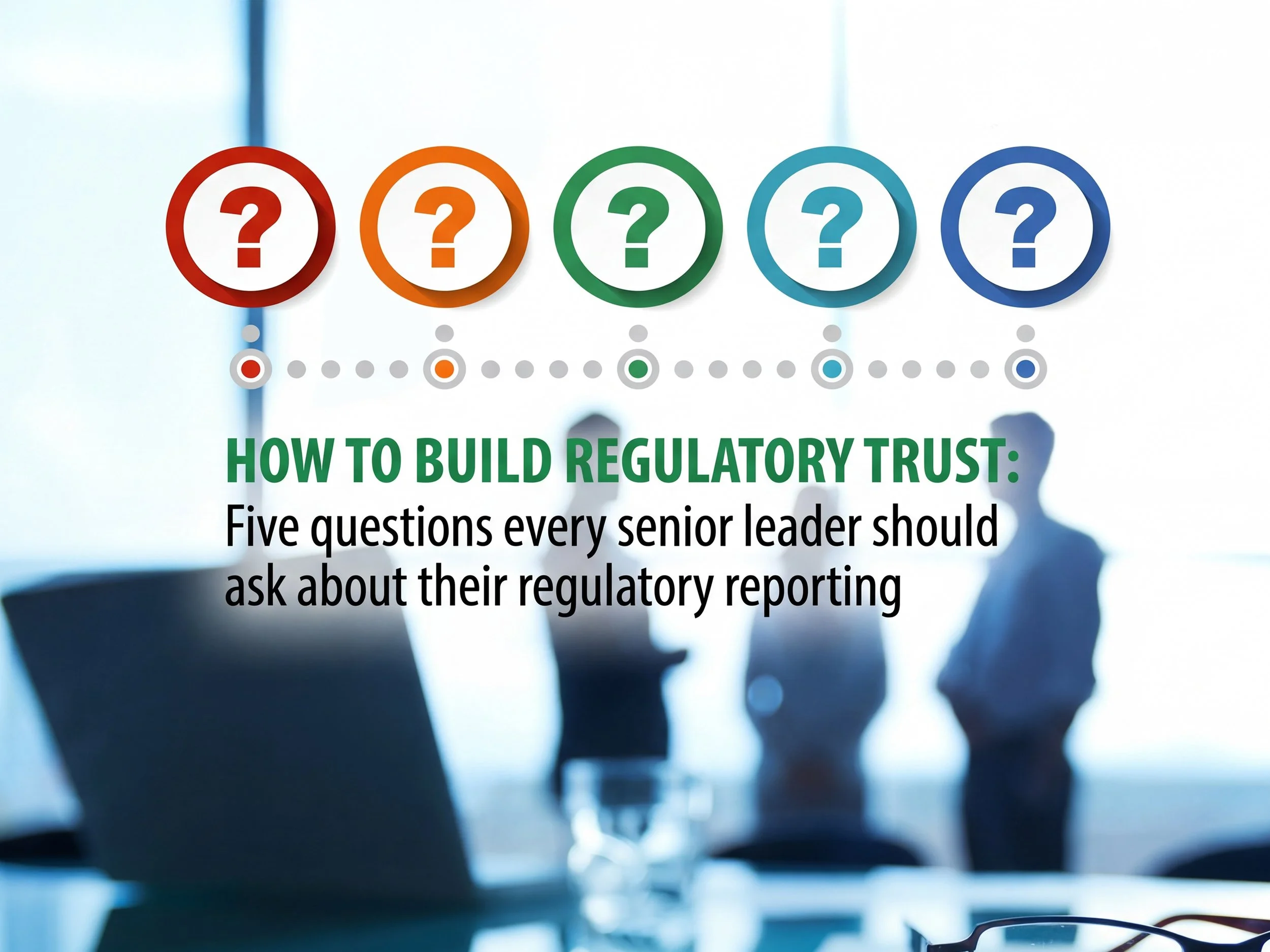The Illusion of Assurance: why your Independent Review may be putting you at risk
Why review quality is now a strategic and commercial priority for boards
For members of the Stockbrokers and Investment Advisers Association (SIAA), the quality of Independent reviews is no longer just a risk or compliance matter - it is a frontline issue for governance, reputation and commercial viability. As regulatory expectations tighten and counterparties demand greater assurance, reviews that once sufficed as internal checks are now being used to judge institutional maturity. ASIC, APRA and AUSTRAC have each made it clear: documentation is not enough. Reviews must validate actual performance, examine operational resilience, and demonstrate genuine independence.
Independent reviews have traditionally been viewed as a procedural comfort, an annual hygiene exercise designed to demonstrate good governance and satisfy regulatory expectation. But the past two years have brought a fundamental shift. Today, reviews are no longer artefacts of compliance. They are a central pillar of operational credibility and commercial positioning.
Regulators have reset the standard. APRA’s CPS230, AUSTRAC’s operational scrutiny, and ASIC’s governance-focused reviews all converge on a single message: boards must demand assurance that is Independent, tested, and embedded. Reviews that rely solely on documentation or management attestations will no longer hold water. If reviews do not include observed performance, operational validation, and independent scope, they will not meet regulator expectations. Worse, they may create false confidence and expose directors to unnecessary risk.
ASIC's 2025 review of managed investment schemes made this plain. Despite the sector's regulatory visibility, the review revealed systemic failures in how boards rely on documentation as evidence of control. Compliance plans had not been updated, dispute resolution processes were unclear or absent, and reviews had been presented as "Independent" despite avoiding operational testing. In multiple cases, governance frameworks appeared robust on paper, but collapsed under scrutiny.
This is not an isolated pattern. It is the new baseline. The review, once seen as a tick-the-box exercise, is now a measure of institutional maturity.
Boards across the SIAA community are uniquely exposed. Operating within highly intermediated value chains, often with outsourced and third-party dependencies, brokers and advisers are now expected to demonstrate resilience not just in market-facing infrastructure, but across operational controls, cyber functions, and compliance handoffs. Without a tested review process, assurance collapses at the first challenge.
A commercial and governance inflection point
As regulatory expectations rise, so too do commercial ones. Across financial services, review quality is becoming a condition of participation. Banks, super funds and wealth platforms now include substantive review requirements in RFIs, onboarding protocols, and ongoing vendor assessments.
Procurement processes ask not only for evidence of policies but for tested control performance. Contracts increasingly embed audit rights, response validation clauses, and requirements to demonstrate operational resilience at the third- and fourth-party level. Service providers who cannot produce recent, Independent, and operationally grounded reviews are being excluded from key opportunities.
Boards that treat reviews as internal artefacts, something managed quietly by risk teams or compliance functions, are being left behind. In this context, assurance is not just a governance function. It is a strategic differentiator.
The commercial stakes are already visible. The white paper License to Operate details how Independent reviews have influenced competitive outcomes. In one example, a large platform provider lost a material distribution arrangement after failing to demonstrate third-party control testing. In another, a superannuation fund required suppliers to evidence Independent cyber reviews before renewing integration contracts. These are not hypotheticals. They are the new reality of financial services.
For SIAA members, this shift is especially acute. Many operate under authorisations or in alliance with upstream platforms. Increasingly, platform partners are embedding resilience expectations into network due diligence. Firms that fail to present credible Independent reviews are facing not only regulatory scrutiny, but commercial exclusion.
What this means for Directors
For directors, the implication is clear. The presence of a review is no longer enough. The question is whether the review was constructed to validate performance, not just confirm structure.
A review that avoids control walkthroughs, skips staff interviews, or relies solely on policy assessment is not Independent. A review conducted by a firm with a parallel advisory role is not Independent. A review that reassures but does not test is not assurance.
Boards must interrogate the reviews they receive:
Who commissioned the review and who scoped it?
Was evidence drawn from observed performance or from documentation?
Were staff across operational functions engaged?
Were failure scenarios tested and escalations walked through?
Was challenge embedded into the methodology?
If these questions cannot be answered clearly, the review should not be relied upon for assurance.
This is not about over-engineering or gold-plating. It is about recognising that in an environment of systemic risk, reputational interdependence, and increasing regulatory scrutiny, review quality directly impacts board accountability.
As ASIC has put it: "Reliance on outdated or incomplete documentation is not a defence. It is a red flag."
For brokers and licensee-aligned advisory firms, the risk is amplified by speed. Market events, system outages, or even a cyber notification can trigger immediate downstream escalation. A shallow review that seemed fit for purpose in planning cycles may prove inadequate when evidence is demanded under pressure.
A note on our position
Oceanic Consulting Group provides both advisory and Independent review services. That dual role creates a perceived conflict, and it is important to acknowledge it plainly.
We are deeply familiar with the practical challenges of designing reviews that are both operationally meaningful and regulator-ready. Our concern is not theoretical. It comes from direct engagement with organisations navigating increased scrutiny and market pressure. We have seen where reviews add real value, and where they fall short.
The standards outlined in this article reflect what we believe is now expected across the industry, not only by Regulators but by boards, investors, and clients.
For the SIAA community, we believe reviews should do more than satisfy internal comfort. They should be capable of being surfaced in due diligence, presented to Regulators, and tested under pressure.
Referencing the full paper: five case studies that matter
In our full 30-page white paper (and yes, we know you have to be a risk enthusiast to read 30 pages on review independence), we cover real-world examples that illustrate this shift in regulatory and commercial expectation. Key case studies include:
ASIC’s 2025 Review of Managed Investment Schemes: Highlighting how well-documented compliance plans failed to reflect operational readiness, leading to increased board exposure.
FIIG Securities: A data breach that exposed 18,000 clients and revealed cyber governance failures, despite the existence of formal policies. The lack of testing, review, and readiness led to ASIC enforcement.
UK FCA Supervision (PS21/3): UK Regulators found that while documentation was compliant, resilience was untested and tolerance metrics were vague. Scenario testing was often absent.
European Union’s DORA Regime: Demonstrated how Regulators are now holding third- and fourth-party service providers directly accountable for operational resilience.
SEC Enforcement Against Ashford Asset Management: Where a documented cyber policy proved useless when the board had no visibility into execution and response protocols failed under pressure.
These case studies reinforce a clear trajectory: Regulators now expect control testing, operational observation, and substantive evidence. Documentation is not enough.
Practical considerations: What good looks like
A substantive review is built differently. It includes:
Transaction sampling;
Scenario simulations;
Staff engagement across business and operational functions;
Testing of escalation pathways and control handoffs;
Observations of performance under real or simulated pressure; and
An Independent reviewer with no advisory conflict and no constraints on scope.
The review is typically commissioned by the board or risk committee, not scoped exclusively by management. It is designed to challenge, not just confirm. It produces insights, not just validation.
Boards that embed this approach create a stronger feedback loop between assurance, governance, and performance.
The question boards must now ask
Boards need to move beyond the assumption that a completed review equals assurance. In the current environment, a poorly scoped or superficially executed review can be more dangerous than no review at all. It may foster overconfidence, delay remediation, or expose directors to liability.
So the question boards must now ask is not:
"Have we completed our Independent review this year?"
It is:
“Are we being told we are resilient, or have we tested it?”
Read the full paper
This article is adapted from License to Operate: Reviews That Secure Relationships and Revenue, published by Oceanic Consulting Group in July 2025.





















